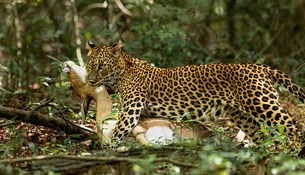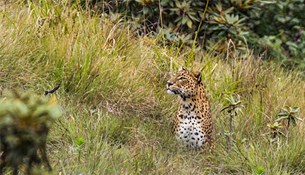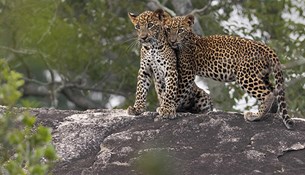Highlights
Leopard safaris in Sri Lanka at 3 very different locations
Plenty of time in each location
Superb holiday for keen wildlife photographers & naturalists
Outline Itinerary
Day
1 Depart UK
2 Arrive Sri Lanka. Transfer to Wilpattu National Park.
3-6 Safaris in Wilpattu
7 Transfer to Nuwara Eliya
8 - 9 Safaris on Horton Plains
10 To Panama
11 - 14 Safaris in Kumana
15 To Galle and visit the fort
16 To airport and depart Sri Lanka. Arrive UK
Cost
Please contact us for prices
Departure Dates
Any day to your requirements




Description
The island nation of Sri Lanka is home to some of the highest densities of leopards in the world, and their habitats vary greatly across the island they call home. Despite the small size of the island compared to the larger mainland, Sri Lanka boasts a multitude of eco systems and biomes, with each one being different to the other. Leopards are found in most of them and being the most adaptable big cat in the world they have adapted to not just survive in isolated wilderness areas but also side by side with human habitations including villages and tea estates.
The Sri Lankan leopard (Panthera pardus kotiya) is an endemic sub species of the leopard genus (Panthera pardus) found only in Sri Lanka. Visually different to the leopards seen in the mainland of Asia as well as Africa, the Sri Lankan leopard is the undisputed ruler of the Sri Lankan wilderness with no competition from larger predators. With this advantage, the leopards on the island are seen more often out in the open and with an air of confidence that sub species in India and Africa often do not have due to competition from larger predators. The Sri Lankan subspecies is also known to share the title of the largest sub species of leopard along with the Persian Leopard.
As a photographer there is always a rush of adrenaline when coming face to face with this majestic big cat in the wild, and to photograph them in varying habitats and ecosystems gives pictorial opportunities like no other. With this in mind, this specially crafted safari focusses primarily on the Sri Lankan leopard in three varying habitats on the island. During this safari you will also encounter many other mammal species such as the critically endangered Sri Lankan sloth bear, Sri Lankan elephant and wild Asiatic water buffalo among many others as well as countless species of birds.
The three habitats for this island safari are Wilpattu National Park, Horton Plains National park and Kumana National Park.
Wilpattu National Park
Wilpattu National Park is Sri Lanka’s largest protected area and located in the north western corner of the island. The habitat primarily is tropical dry mixed evergreen forests. This results in sightings of leopards in beautiful deep dark forests, with tall dense trees and vines giving a very unique setting for photography. Besides the forests, the park as its name suggests has many natural lakes named villu’s. These lakes have beautiful white sandy brims along the edge, as well as a few areas of white sand dunes in certain areas of the park. Leopards are often photographed on these white sands which are akin to snow. The overall beauty of the landscapes and the multitude of photography opportunities Wilpattu presents proves to be irresistible to keen wildlife photographers.
Horton Plains National Park
Horton Plains National Park is set high up in the mountains in the central region of the island. This is a UNESCO World Heritage Site and a biodiversity hotspot with high ecological significance. Most of the fauna and flora in this region are endemic to Sri Lanka and found no where else in the world. The typical landscapes of Horton Plains include rolling plains of grasslands and montane cloud forests which seem quite unreal and mystical in nature with other magnificent mountains serving as a background. This montane ecosystem is also home to the apex predator of the island. With the higher altitude and possibly the high density of quality prey in the form of the sambhur deer, the leopards in these highlands are generally larger, bulkier and with a broader skull and shorter muzzle giving it a distinctive look compared to its lowland cousins.
Seeing a leopard in this habitat though is more difficult and requires the skills of keen spotters. The leopards camouflage perfectly with the grass as they stalk their prey, and are often more shy in nature. But a sighting in Horton Plains is always magnificent with the stunning backgrounds and landscapes unique to the highlands. One of the key signs to listen out for is the alarm call of the sambhur and then to read their body language and actions such as stomping the ground. Using these field tracking skills and patience are key in spotting these elusive cats, and though at the beginning of a find they maybe seen at a distance, a good understanding of their key movement points by the guides will help in being in the right place at the right time to be able to get a close encounter when the time is right.
Besides the leopards, the park is home to many species of endemic birds such as the legendary Sri Lanka whistling thrush, Sri Lanka bush warbler, dusky blue flycatcher, yellow-eared bulbul and Sri Lanka white eye to name a few. From a mammal point of view besides the leopards and sambhur, you may come across the beautiful golden coated species of mongoose known as the stripe-necked mongoose, as well as the shaggy coated endemic primate the purple faced leaf langur and if you are really luck the Eurasian otter can be found in many of the small ponds scattered across the park. Other photographic opportunities arise with endemic lizards and butterflies.
Kumana National Park
Next you move down to the southeast and the arid dry coastal wilderness of Kumana National Park. This is perhaps the last wild frontier of Sri Lanka tucked away in a far corner of the island and not easily accessible without some travelling. It is our favourite park on the island and for good reason. Once a bird sanctuary it is now a booming leopard destination with magical leopard sightings as well as many herds of Sri Lankan elephants, intimidating Asiatic water buffalo and so much more.
The habitat of Kumana is very different to that of Wilpattu and Horton Plains, as being a coastal dry arid habitat, the area has scatterings of bushy areas, stretches of beaches and open lagoons and plains as well as a host of large rocky outcrops which the leopards love to frequent. Iconic settings where leopards can be seen in Kumana include the open plains and rocky outcrops but equally they can be found up in the trees. A dream sighting which would be rare, but very much a possibility, is to capture a glimpse of a leopard walking along the beach with the Indian Ocean in the background.
Thus this multi day safari experience truly gives the keen naturalist, big cat enthusiast or photographer three unique habitats in which to discover one of the most enigmatic big cats in the world.